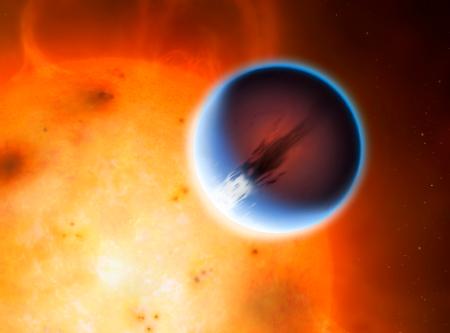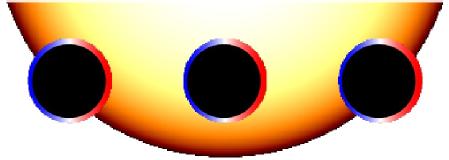5400mph winds discovered hurtling around planet outside solar system
-
Research provides first ever weather map of a planet outside our solar system
-
“This is the first ever weather map from outside of solar system.”
-
Wind 20x faster than ever recorded on Earth
-
Measurement techniques could be used to study weather on Earth-like planets
 Winds of over 2km per second have been discovered flowing around planet outside of the Earth’s solar system, new research has found.
Winds of over 2km per second have been discovered flowing around planet outside of the Earth’s solar system, new research has found.
The University of Warwick discovery is the first time that a weather system on a planet outside of Earth’s solar system has been directly measured and mapped.
The wind speed recorded is 20x greater than the fastest ever known on earth, where it would be seven times the speed of sound.
Commenting on the discovery lead researcher Tom Louden, of the University of Warwick’s Astrophysics group, said:
“This is the first ever weather map from outside of our solar system. Whilst we have previously known of wind on exoplanets, we have never before been able to directly measure and map a weather system.”
Discovered on the exoplanet HD 189733b, the Warwick researchers measured the velocities on the two sides of HD 189733b and found a strong wind moving at over 5400mph blowing from its dayside to its night side. Mr Louden explains:
“HD 189733b’s velocity was measured using high resolution spectroscopy of the Sodium absorption featured in its atmosphere. As parts of HD 189733b’s atmosphere move towards or away from the Earth the Doppler effect changes the wavelength of this feature, which allows the velocity to be measured”.
Explaining how this information was used to measure velocity Mr Louden says:
“The surface of the star is brighter at the centre than it is at the edge, so as the planet moves in front of the star the relative amount of light blocked by different parts of the atmosphere changes. For the first time we've used this information to measure the velocities on opposite sides of the planet independently, which gives us our velocity map.”
The researchers say that the techniques used could help the study of Earth-like planets. Co-researcher, Dr Peter Wheatley of the University of Warwick’s Astrophysics Group explains:
"We are tremendously excited to have found a way to map weather systems on distant planets. As we develop the technique further we will be able to study wind flows in increasing detail and make weather maps of smaller planets. Ultimately this technique will allow us to image the weather systems on Earth-like planets. "
HD 189733b is one of the most studied of a class of planets known as 'Hot Jupiters'. At over 10% larger than Jupiter, but 180x closer to its star, HD 189733b has a temperature of 1200'C. Its size and relatively closeness to our solar system make it a popular target for astronomers. Past research has shown that the day side of the planet would appear a bright shade of blue to the human eye, probably due to clouds of silicate particles high in its atmosphere.
The data was collected by HARPS, the High Accuracy Radial velocity Planet Searcher, in La Silla, Chile.
The research, Spatially resolved eastward winds and rotation of HD 189733b, is published by Astrophysical Journal Letters.
ENDS.
13 November 2015
Notes:
Link to paper: http://arxiv.org/abs/1511.03689
Image Captions:
-
HD189733: The planet HD 189733b is shown here in front of its parent star. A belt of wind around the equator of the planet travels at 5400mph from the heated day side to the night side. The day side of the planet appears blue due to scattering of light from silicate haze in the atmosphere. The night side of the planet glows a deep red due to its high temperature.
http://www2.warwick.ac.uk/services/communications/medialibrary/images/november2015/hd189733.jpg <<Credit to Mark A. Garlick/University of Warwick
-
Diagram.png: The planet is shown at three positions as it crosses its parent star. The changing background illumination allows us to separate absorption from different parts of the planetary atmosphere. By measuring the Doppler shift of the absorption we are able to measure wind velocities. The blue-shaded region of the atmosphere is moving toward the Earth at 12,000 mph, while the red-shaded region is moving away from the earth at 5,000 mph. After correcting for the expected spin of the planet we measure a wind velocity of 5400 mph on the blue side, indicating a strong eastward wind flow from the heated day side to the night side of the planet. http://www2.warwick.ac.uk/services/communications/medialibrary/images/november2015/diagram.jpg
Acknowledgements:
Tom Louden is supported by a STFC studentship and Dr Wheatley by a STFC consolidated grant.
Contact: Tom Frew - International Press Officer, University of Warwick
E: a dot t dot frew at warwick dot ac dot uk
T: +44(0)7785433155
